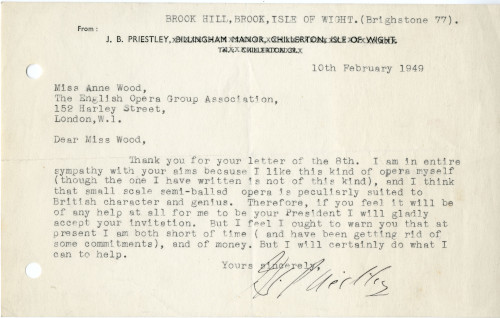The English Opera Group collection forms part of the Britten Pears Arts Archive which documents the lives and work of composer Benjamin Britten and his partner, singer Peter Pears, as well as their wider collaborative relationships through the papers of singers, librettists, producers, designers and other creatives with whom they worked. Of all the collections in our archive perhaps this one illustrates the workings of these creative partnerships most effectively. Opera is a collaborative art form – a union of several different arts. It requires the talents and inspiration of people from music, literature, drama, painting, and stage and costume design, as well as the skills of electricians, carpenters, costume makers and administrators. The archive of the English Opera Group documents the process of creating an opera from planning to performance as well as the people involved from the Board of Directors to the singers on stage.
The English Opera Group was founded in 1947 by Britten, librettist and producer Eric Crozier, and artist and designer John Piper. These three creatives regretted that England had never had a tradition of native opera but depended instead on a repertory of foreign works. Their aim therefore was to encourage British composers to write for the operatic stage and poets and playwrights to write libretti – and so build a repertory of English opera.
They considered the best way to achieve this was to focus on the creation of chamber operas requiring small numbers of singers and players. These chamber operas would be suitable for simpler staging, for performance in either large or small theatres or halls and be easier to take on tour. They would therefore require less financial commitment and could be presented by companies who lacked the resources needed to present the large-scale grand operas of the traditional repertory.

Britten, Crozier and Piper produced their first chamber opera in 1946 – Britten’s The Rape of Lucretia written for 8 singers and an orchestra of 12. The success of this experiment encouraged them to continue their work by establishing a group of singers under their artistic direction. The new opera company was launched with the creation of Britten’s second chamber opera Albert Herring in 1947.
Despite working with the reduced forces of a chamber opera, financial assistance from the Arts Council did not cover the Group’s costs and so the English Opera Group Association was founded a year later in 1948 to provide support as well as a link between performers and audience. The Association raised funds through subscriptions, concerts and events, including Opera Balls with the attendees dressing up as operatic characters. The Association’s first president J.B. Priestley was sympathetic to the Group’s aims and methods believing that small-scale chamber operas suited the ‘British character and genius’.

The English Opera Group continued to create first productions of new chamber operas by Britten – with first performances taking place at the annual June Aldeburgh Festival of Music and the Arts. In 1951 the Group set about its aim of encouraging further British composers and writers to write for the operatic stage with its first commission – The Sleeping Children with music by Brian Easdale and libretto by Tyrone Guthrie. Over the next 23 years the Group commissioned and produced ten further operas for chamber forces with music by British composers, including operas by Lennox Berkeley, Malcolm Williamson, William Walton and Harrison Birtwistle.

In 1964 the Group gave the first performance of Britten’s Curlew River – his first parable for church performance – a new experiment in composition and production and based on the Japanese Nō drama Sumidagawa. The Group toured widely throughout the UK and abroad, performing in the USSR in 1964, and at Expo 67 in Montreal. In 1975 the Group was expanded and reformed as the English Music Theatre Company, the change of name reflecting a broadening of repertory to include, as well as operas, operettas and musicals. The company produced its last opera and ceased to operate in 1980 due to financial difficulties.
The archive of the English Opera Group, later the English Music Theatre Company, is extensive, providing information on the operas produced and people involved throughout its history. There are papers relating to policy and planning, organisation, publicity and finances; files concerning artists and personnel, performances and tours. The creative process is recorded in production scores with rehearsal markings, technical and wardrobe files, set designs and production photographs. We have recorded oral history interviews with former members to provide further insights into the Group’s story. This collection has recently been catalogued and is now available for research.
Judith Ratcliffe
Archivist, Britten Pears Arts
The Red House, Aldeburgh, Suffolk
www.brittenpearsarts.org
Related
English Opera Group / English Music Theatre Company archive
Correspondence of Benjamin Britten
Correspondence of Peter Pears
Nancy Evans and Eric Crozier papers
Descriptions of other collections held by Britten Pears Arts Archive can be found on Archives Hub here:
https://archiveshub.jisc.ac.uk/search/locations/db6ce751-8321-3ca4-9e5b-79f76ef04ac0
Previous Archives Hub feature on Britten Pears Arts Archive collections
The Imogen Holst archive: papers of a passionate and open-minded woman musician
Images copyright Britten Pears Arts Archive and the Estate of J.B. Priestley. Reproduced with the kind permission of the copyright holders.



